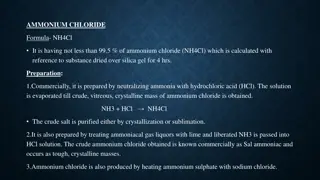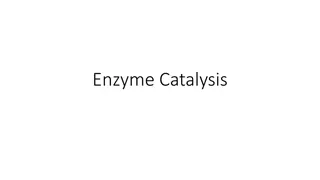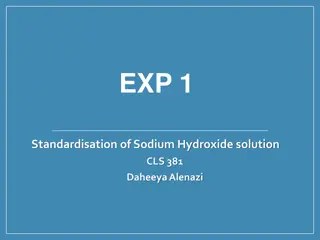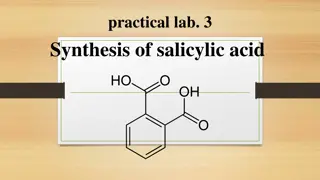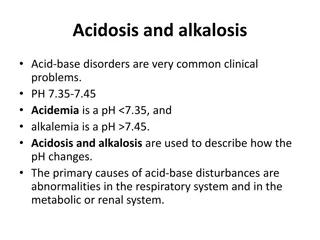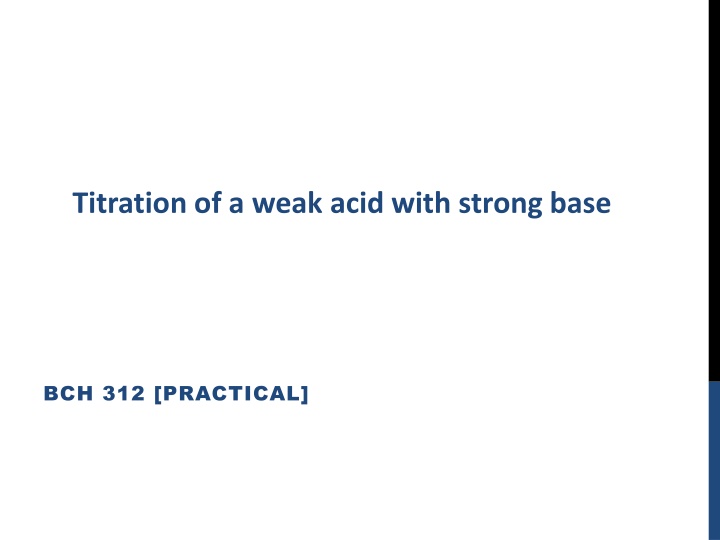
Titration of Weak Acids with Strong Bases
Explore the titration of weak acids with strong bases, including determining pKa values and understanding buffers. Learn about titration curves, dissociation groups, and pH calculations for weak acids.
Download Presentation

Please find below an Image/Link to download the presentation.
The content on the website is provided AS IS for your information and personal use only. It may not be sold, licensed, or shared on other websites without obtaining consent from the author. If you encounter any issues during the download, it is possible that the publisher has removed the file from their server.
You are allowed to download the files provided on this website for personal or commercial use, subject to the condition that they are used lawfully. All files are the property of their respective owners.
The content on the website is provided AS IS for your information and personal use only. It may not be sold, licensed, or shared on other websites without obtaining consent from the author.
E N D
Presentation Transcript
Titration of a weak acid with strong base BCH 312 [PRACTICAL]
Objective: -To study titration curves. -Determine the pKa value of a weak acid. -Reinforce the understanding of buffers.
Weak Acid : Weak acids or bases do not dissociate completely, therefore an equilibrium expression with Ka must be used. The Ka is a quantitative measure of the strength of an acid in solution. since it s value is always very low, Ka is usually expressed as pKa , where: pKa = - log Ka As an acid/base get weaker, its Ka/Kb gets smaller and pKa/pKb gets larger. For example: - HCl is a strong acid , it has (1 107Ka value) and ( -7 pKa value). - CH3COOH is a weak acid , it has (1.76 x 10-5Ka value) and (4.75 pKa value).
Weak Acid cont. : Type of weak acid: - Monoprotic (can donate one hydrogen ion ). e.g.: CH3COOH - Diprotic (can donate two hydrogen ion ). e.g.: H2SO4 - Triprotic (can donate three hydrogen ion ). e.g.: H3PO4 each group has own Ka value. Which dissociation group will dissociate first? The group that has higher Ka value or i.e that has lower pKa value pKa values of weak acids can be determined mathematically or practically by the use of titration curves. **Review the calculation of pH of weak acid/base
Titration Curves: Titration Curves are produced by monitoring the pH of a given volume of a sample solution after successive addition of acid or alkali. The curves are usually plots of pH against the volume of titrant added (acid or base). There are many uses of titration, one of them is to indicate the pKa value of the weak acid by using the titration curve. Each dissociation group represent one stage in the titration curve.
Titration Curves: pH one stage
Middle point 5 3 4 2 1
[1] Before any addition of strong base the (starting point), ALL weak acid is in the form of full protenation [CH3COOH] ; all weak acid as electron donor. In this point PH of weak acid < Pka. We can calculate the pH from: pH = (pKa + p[HA]) / 2
[2] When certain amount of strong base added (any point before the middle of titration), the weak acid starting dissociate , [CH3COOH]>[CH3COO-] = ( Donor > Acceptor). -In this point the PH of weak acid < Pka. We can calculate the pH from: pH = pKa + log ( [A-] / [HA] )
[3] point At middle of titration, [CH3COOH]=[CH3COO-] (Donor=Acceptor) , PH=Pka , The component of weak acid work as Buffer that has maximum buffer capacity (A solution that can resistant the change of PH) . - Buffer capacity= pKa 1 **Pka define as: The PH value at middle of titration at which they will be [donor]=[acceptor]. We can calculate the pH from: pH = pKa + log ( [A-] / [HA] ) Middle point
[4] At any point after mid of titration and before end point, [CH3COOH]<[CH3COO-] , (donor<Acceptor) , in this point the PH > Pka. We can calculate the pH from: pH = pKa + log ( [A-] / [HA] ) [5] Finally ; At the end point, the weak acid will fully dissociation (electron acceptor) , [CH3COO-] . In this point pH > pKa Approximately, all the solution contains CH3COO- , so we first must calculate pOH, then the pH: pOH = (pKb + p[A-]) / 2 pH = pKw pOH *pKb = pKw - pKa
Now, How to calculate the pH value at these different points? [1] At starting point: PH= (Pka+P[HA])/2. [2] At any point within the curve (after , in or after middle titration): PH=Pka+log[A-]/[HA]. [3] At end point: POH=(PKb+P[A-])/2 PH=PKw POH -Henderson-Hasselbalch equation is an equation that is often used to : 1- to calculate the PH of the Buffer 2-to preparation of Buffer. 3- to calculated the PH in any point within the titration curve (Except starting and ending point)
Note: If you start titration using 20 ml of the weak acid, In titration curve .. a] The total volume of weak acid is 20 ml , we need 20 ml of strong base to full dissociate the group of weak acid. b] We can reach to middle titration if we add 10 ml of strong base (half the amount of 20 ml). ** How we can determine the Pka from the curve?? Bearing in mind that : 1. the weak acid and the strong base (titrant) should have the same concentration. 2. the weak acid and strong base should have the same protonation and hydroxylation state respectively (ex: monoprotic acid and monohydroxy base).
Example: determine the PH value of 500 ml of monoproteic weak acid (0.1M) , titrated with 0.1M KOH (Pka=5), after addition: 100 ml , 250 ml , 375 and 500 ml of KOH?? [1] PH after addition of 100 ml of KOH? We will use: PH= Pka + log[A-]/[HA] we know that HA + KOH KA + H2O -We should calculate the No. of moles of remaining [HA] and No. of moles of KOH added first to calculate the concentrations of [A-]/[HA], that will help us to determine pH value at this point. (we should calculate the No.of mole of the original acid before any additions of base why?) Mole of HA [original] mole of KOH [added] = mole of HA remaining. -No. of KOH mole = 0.1 X 0.1 L = 0.01 mole -No. of HA mole originally = 0.1 X 0.5 L =0.05 mole -No. of HA mole remaining = 0.05 0.01 = 0.04 mole So, PH = 5 + log [0.01]/[0.04] PH = 4.4 note: the pH<pKa
[2] after addition of 250 ml of KOH?? We will use : pH= pKa + log[A-]/[HA] Mole of HA [originally] mole of KOH [added] = mole of HA remaining. -No. of KOH mole = 0.1 X 0.25 L = 0.025 mole No. of HA mole originally = 0.1 X 0.5 L =0.05 mole -No. of HA mole remaining = 0.05 0.025 = 0.025 mole PH = 5 + log [0.025] / [0.025] PH=5 =PKa (at mid point , The component of weak acid work as a Buffer , has a buffering capacity 5 1 )
[3] after addition of 375 ml of KOH?? We will use : pH= pKa + log[A-]/[HA] Mole of HA [originally] mole of KOH [added] = mole of HA remaining. -No. of KOH mole = 0.1 X 0.375 L = 0.0375 mole No. of HA mole originally = 0.1 X 0.5 L =0.05 mole -No. of HA mole remaining = 0.05 0.0375 = 0.0125 mole PH = 5 + log 0.0375/0.0125 PH= 5.48 note: the pH>pKa slightly
[4] after addition of 500 ml of KOH?? Note: 500 ml the same volume of weak acid that mean the all weak acid are as [CH3COO]). We will use,POH = (PKb + P[A-])/2 first, PKb= PKw - Pka second, PKb= 14 5 = 9 P[A-]= - log [A-] [A-]=?? No of a mole KOH= 0.1 X 0.5 = 0.05 mole (total volume = 500+500=1000= 1L) Molarity of [A-] = 0.05 mole/1 L =0.05 M So, P[A-]= - log 0.05 = 1.3 Compensation in the equation , POH = (PKb + P[A-])/2 : -POH=(9+1.3)/2 = 5.15 note: the pH>pKa -PH=PKw-POH PH = 14 5.15 = 8.85






